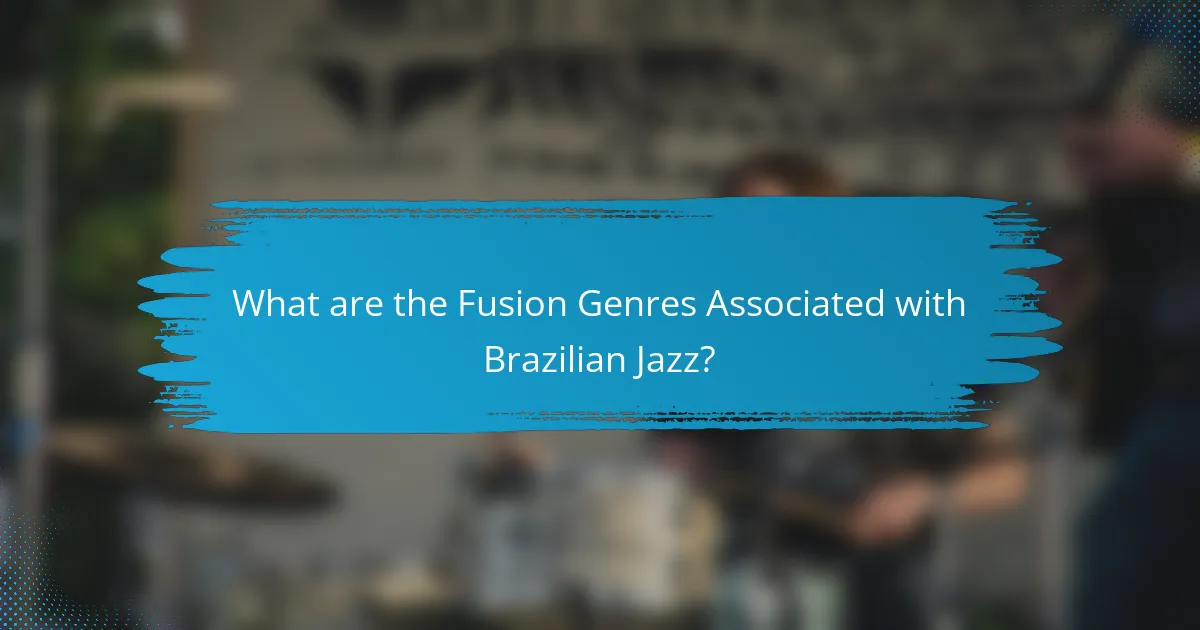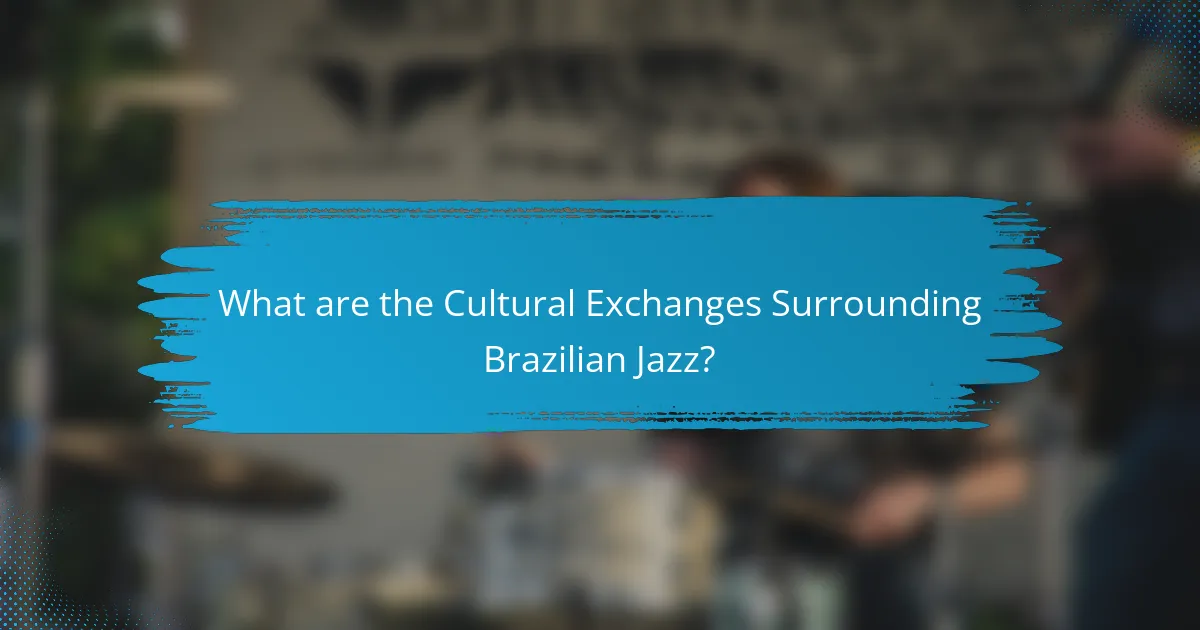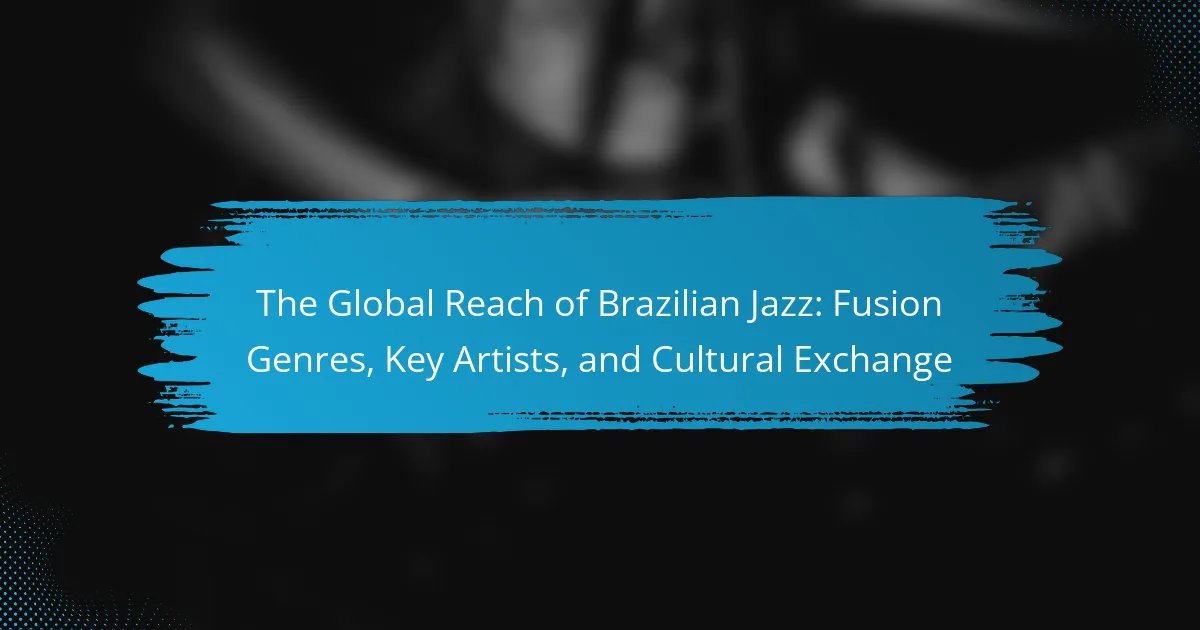Brazilian Jazz is a musical genre that merges traditional Brazilian styles, including samba and bossa nova, with jazz influences, originating in the mid-20th century. Key artists such as Antonio Carlos Jobim and João Gilberto played pivotal roles in popularizing bossa nova on a global scale. This genre has led to the creation of fusion styles like samba jazz and MPB (Música Popular Brasileira), reflecting a rich cultural exchange that incorporates African, European, and indigenous musical elements. The global impact of Brazilian Jazz is evident through collaborations with international musicians and events like the Montreux Jazz Festival, showcasing its ongoing evolution and influence in the world of music.

What is Brazilian Jazz and its Global Influence?
Brazilian Jazz is a genre that blends traditional Brazilian music styles, such as samba and bossa nova, with jazz elements. It emerged in the mid-20th century, influenced by jazz musicians visiting Brazil and local artists experimenting with new sounds. Key artists include Antonio Carlos Jobim and João Gilberto, who popularized bossa nova internationally. Brazilian Jazz has had a significant global influence, inspiring musicians worldwide to incorporate its rhythms and harmonies into their work. The genre has contributed to the development of fusion genres like Latin jazz. Its impact is evident in the works of artists across various music styles, demonstrating the cultural exchange between Brazil and the global music scene.
How did Brazilian Jazz originate and evolve over time?
Brazilian Jazz originated in the early 20th century as a fusion of traditional Brazilian music and jazz influences. The genre emerged from the cultural melting pot of Brazil, particularly in cities like Rio de Janeiro and São Paulo. It combined elements of samba, bossa nova, and other Brazilian styles with jazz improvisation and harmonies.
In the 1930s, musicians like Ary Barroso and João Gilberto began to popularize these blends. The bossa nova movement in the late 1950s further propelled Brazilian Jazz into the global music scene. Artists such as Antonio Carlos Jobim and Stan Getz played pivotal roles in this evolution.
By the 1960s and 1970s, Brazilian Jazz incorporated various international influences, expanding its reach. This genre continued to evolve, integrating elements from rock, funk, and electronic music. Today, Brazilian Jazz remains a vibrant and dynamic genre, celebrated for its rhythmic complexity and cultural richness.
What are the key historical events that shaped Brazilian Jazz?
Brazilian Jazz was shaped by several key historical events. The emergence of samba in the early 20th century laid the foundation for Brazilian Jazz. The 1930s saw the rise of bossa nova, integrating jazz elements with traditional Brazilian music. In 1956, the album “Jazz Samba” by Stan Getz and Charlie Byrd popularized Brazilian rhythms in the United States. The Tropicália movement in the late 1960s blended Brazilian music with international styles, further influencing jazz. The 1990s brought a resurgence of interest in Brazilian Jazz, with artists like Antonio Carlos Jobim gaining international acclaim. The globalization of music in the 21st century has led to cross-cultural collaborations, expanding the genre’s reach. Each of these events contributed to the evolution and global appreciation of Brazilian Jazz.
How did cultural exchanges contribute to the development of Brazilian Jazz?
Cultural exchanges significantly shaped the development of Brazilian Jazz. The genre emerged from the fusion of African, European, and indigenous musical traditions. African rhythms and instruments, such as the berimbau and atabaque, influenced Brazilian Jazz’s percussive elements. European harmonies and melodies contributed to its structural complexity. Brazilian Jazz also incorporated elements of American jazz, particularly in the 20th century. Notable artists, like Antonio Carlos Jobim and Gilberto Gil, blended these influences in their compositions. The cultural exchange fostered innovation, leading to new styles like bossa nova and samba jazz. This genre’s evolution reflects the rich tapestry of Brazil’s multicultural heritage.
What are the defining characteristics of Brazilian Jazz?
Brazilian Jazz is characterized by its fusion of traditional Brazilian music styles with jazz elements. Key styles include bossa nova, samba, and choro. Bossa nova features smooth melodies and syncopated rhythms. Samba adds lively beats and vibrant instrumentation. Choro incorporates improvisation and intricate melodies. Brazilian Jazz often emphasizes rich harmonies and complex chord progressions. The use of acoustic instruments, like guitar and piano, is prevalent. Influential artists, such as Antonio Carlos Jobim and João Gilberto, helped popularize this genre. Brazilian Jazz reflects the cultural diversity of Brazil, blending African, European, and indigenous musical influences.
What musical elements differentiate Brazilian Jazz from other genres?
Brazilian Jazz is distinguished by its unique blend of rhythmic complexity, melodic richness, and cultural influences. The genre incorporates syncopated rhythms, often derived from samba and bossa nova. These rhythms create a distinctive groove that sets it apart from other jazz forms.
Melodically, Brazilian Jazz frequently utilizes lush harmonies and intricate chord progressions. This approach is influenced by Brazilian folk music and classical traditions. Instruments like the guitar, piano, and percussion play a crucial role in shaping its sound.
Additionally, Brazilian Jazz often features improvisation, a hallmark of jazz, but with a unique flair influenced by Brazil’s diverse musical heritage. The integration of traditional Brazilian instruments, such as the berimbau and cuíca, further enhances its distinctiveness.
Overall, the combination of rhythmic innovation, melodic depth, and cultural fusion characterizes Brazilian Jazz and differentiates it from other genres.
How do rhythms and instruments influence the sound of Brazilian Jazz?
Rhythms and instruments significantly shape the sound of Brazilian Jazz. The genre incorporates diverse rhythms such as bossa nova and samba. These rhythms create a unique, syncopated feel that distinguishes Brazilian Jazz from other jazz forms. Instruments like the guitar, piano, and percussion play crucial roles in this sound. The guitar often provides harmonic support and melodic lines, while the piano adds texture and improvisation. Percussion instruments, including the berimbau and pandeiro, contribute to the rhythmic complexity. This blend of rhythms and instruments results in a rich, layered sound. Brazilian Jazz reflects the cultural heritage and musical traditions of Brazil. The integration of various elements creates a dynamic and engaging listening experience.

What are the Fusion Genres Associated with Brazilian Jazz?
Fusion genres associated with Brazilian jazz include bossa nova, samba jazz, and MPB (Música Popular Brasileira). Bossa nova blends samba rhythms with jazz harmonies. It emerged in the late 1950s, featuring artists like João Gilberto and Tom Jobim. Samba jazz combines traditional samba with jazz improvisation. This genre gained popularity in the 1960s with musicians such as Stan Getz. MPB incorporates various Brazilian styles and international influences. It reflects social and political themes, evolving since the 1960s. These genres showcase the rich cultural exchange within Brazilian jazz.
How has Brazilian Jazz influenced other music genres globally?
Brazilian Jazz has significantly influenced various global music genres. Its rhythmic complexity and improvisational style have inspired artists across jazz, pop, and rock. The incorporation of samba and bossa nova has enriched the jazz genre, leading to unique fusions. Notable musicians like Stan Getz and Antonio Carlos Jobim popularized Brazilian rhythms in the United States during the 1960s. This cross-cultural exchange resulted in the emergence of new styles, such as Latin jazz. Additionally, Brazilian Jazz has impacted electronic music, with artists blending traditional sounds with modern production techniques. The global appeal of Brazilian Jazz continues to foster collaborations, enhancing musical diversity worldwide.
What are some notable fusion genres that incorporate Brazilian Jazz?
Notable fusion genres that incorporate Brazilian Jazz include Bossa Nova, Samba Jazz, and Latin Jazz. Bossa Nova blends samba and jazz, originating in the 1950s. It features smooth melodies and complex harmonies. Samba Jazz combines samba rhythms with jazz improvisation. This genre emerged in the 1960s and emphasizes vibrant percussion. Latin Jazz incorporates elements from various Latin American music styles, including Brazilian influences. It often showcases intricate rhythms and improvisation. These genres demonstrate the global influence of Brazilian Jazz on contemporary music.
How do artists blend Brazilian Jazz with different musical styles?
Artists blend Brazilian Jazz with different musical styles by incorporating diverse rhythms and instrumentation. They often integrate elements from genres like funk, rock, and classical music. This fusion creates a unique sound that maintains the essence of Brazilian Jazz. For example, musicians may use traditional Brazilian percussion instruments alongside electric guitars and synthesizers. Notable artists like Hermeto Pascoal and Sergio Mendes exemplify this blending. Their works showcase how Brazilian Jazz can adapt and evolve through collaboration with various musical traditions. This cross-genre experimentation enriches the global music landscape.
What role do key artists play in the global reach of Brazilian Jazz?
Key artists play a crucial role in the global reach of Brazilian Jazz by promoting its unique sound and cultural significance. They often blend traditional Brazilian rhythms with various genres, attracting diverse audiences. Renowned musicians like João Gilberto and Antonio Carlos Jobim helped popularize bossa nova internationally. Their collaborations with global artists expanded the genre’s influence. Festivals featuring Brazilian Jazz showcase its vibrant culture to international audiences. Furthermore, key artists leverage social media to share their music worldwide. This accessibility enhances the genre’s visibility and fosters cultural exchange. Overall, these artists are instrumental in bridging Brazilian Jazz with a global audience.
Who are the most influential Brazilian Jazz musicians and why?
The most influential Brazilian Jazz musicians include Antonio Carlos Jobim, Hermeto Pascoal, and Elis Regina. Antonio Carlos Jobim is known for his role in creating Bossa Nova. His compositions, such as “The Girl from Ipanema,” have gained international acclaim. Hermeto Pascoal is celebrated for his innovative approach to jazz and improvisation. He blends Brazilian folk music with jazz elements, creating unique soundscapes. Elis Regina is recognized for her powerful voice and emotional delivery. She brought Brazilian music to the mainstream and collaborated with various artists, expanding the genre’s reach. Their contributions have shaped Brazilian Jazz and influenced musicians worldwide.
How have these artists contributed to the genre’s popularity worldwide?
These artists have significantly contributed to the worldwide popularity of Brazilian jazz through innovative fusion and global collaborations. Their unique styles blend traditional Brazilian rhythms with various musical genres. For example, artists like Antonio Carlos Jobim popularized bossa nova, which gained international acclaim in the 1960s. The song “The Girl from Ipanema” became a global hit, showcasing Brazilian jazz to a broader audience. Additionally, musicians such as Gilberto Gil and Caetano Veloso incorporated elements of rock and folk, further expanding the genre’s appeal. Their participation in international music festivals has introduced Brazilian jazz to diverse audiences. Collaborations with global artists have also helped bridge cultural gaps. This cross-pollination has led to a richer, more dynamic musical landscape, enhancing the genre’s reach and influence.

What are the Cultural Exchanges Surrounding Brazilian Jazz?
Cultural exchanges surrounding Brazilian jazz include the blending of African, European, and indigenous musical elements. This genre emerged in the early 20th century, influenced by samba and bossa nova. Notable artists like João Gilberto and Antônio Carlos Jobim popularized Brazilian jazz globally. The genre has also incorporated elements from American jazz, creating a unique fusion. Events like the Montreux Jazz Festival showcase this cultural exchange. Collaborative projects with international musicians further enhance its global reach. Brazilian jazz continues to evolve through these dynamic interactions. The genre serves as a bridge connecting diverse cultures through music.
How does Brazilian Jazz facilitate cultural exchange between countries?
Brazilian Jazz facilitates cultural exchange between countries through its unique blend of musical styles and rhythms. This genre incorporates elements from African, European, and indigenous Brazilian music. Artists often collaborate internationally, sharing their cultural backgrounds and experiences. Festivals and concerts featuring Brazilian Jazz attract diverse audiences from around the world. These events promote understanding and appreciation of Brazilian culture. Additionally, the global spread of Brazilian Jazz influences local music scenes, encouraging fusion genres. This cross-pollination enriches both Brazilian music and the cultures it interacts with. The rhythmic complexity and improvisational nature of Brazilian Jazz invite musicians from various backgrounds to participate and innovate.
What are some examples of international collaborations in Brazilian Jazz?
Some examples of international collaborations in Brazilian Jazz include the partnership between Brazilian guitarist João Gilberto and American jazz musician Stan Getz. Their collaboration produced the iconic album “Getz/Gilberto” in 1964, which popularized bossa nova worldwide. Another notable example is the work of Brazilian pianist Eliane Elias with American jazz artists such as trumpeter Randy Brecker. Their collaborations showcase the blend of Brazilian rhythms with jazz improvisation. Additionally, the album “Brasil” by American saxophonist David Sanborn features Brazilian musicians like Ivan Lins, highlighting cross-cultural musical exchanges. These collaborations illustrate the global influence and integration of Brazilian jazz into the wider jazz community.
How do cultural festivals promote Brazilian Jazz on a global scale?
Cultural festivals promote Brazilian Jazz on a global scale by showcasing its unique rhythms and styles. These events often feature renowned Brazilian Jazz artists, attracting international audiences. Festivals serve as platforms for cultural exchange, allowing musicians to collaborate with global talents. They also provide educational workshops that teach attendees about Brazilian music history and techniques. Live performances create immersive experiences that resonate with diverse audiences. Furthermore, media coverage of these festivals enhances visibility for Brazilian Jazz worldwide. This exposure leads to increased interest in the genre, resulting in more international performances and collaborations. Overall, cultural festivals play a crucial role in elevating Brazilian Jazz on the global stage.
What impact does Brazilian Jazz have on contemporary music scenes?
Brazilian Jazz significantly influences contemporary music scenes. It introduces unique rhythms and melodies that enhance various genres. Elements like samba and bossa nova are frequently integrated into pop, rock, and electronic music. Key artists such as Antonio Carlos Jobim and Joao Gilberto have paved the way for this fusion. Their works have inspired countless musicians worldwide. The genre promotes cultural exchange, blending Brazilian sounds with international styles. This interaction fosters innovation and creativity in music production. Brazilian Jazz continues to shape the soundscape of modern music globally.
How is Brazilian Jazz being integrated into modern music genres?
Brazilian Jazz is being integrated into modern music genres through fusion with styles like hip-hop, electronic, and pop. Artists blend traditional Brazilian rhythms with contemporary beats. This creates a unique sound that appeals to diverse audiences. For example, musicians like Seu Jorge and Bebel Gilberto incorporate samba and bossa nova into their music. Collaborations between Brazilian artists and international musicians further enhance this integration. Festivals and music events showcase these hybrid genres, promoting cultural exchange. The global streaming platforms also facilitate the reach of Brazilian Jazz to new listeners. This cross-pollination enriches both Brazilian music and modern genres.
What are the future trends for Brazilian Jazz in the global music landscape?
Future trends for Brazilian Jazz in the global music landscape include increased fusion with other genres. Artists are blending Brazilian Jazz with electronic music, hip-hop, and world music. This fusion creates innovative sounds that appeal to diverse audiences. Collaborations between Brazilian musicians and international artists are becoming more common. These partnerships enhance cultural exchange and broaden the genre’s reach. Festivals and global platforms are showcasing Brazilian Jazz, increasing its visibility. Streaming services are promoting Brazilian Jazz playlists, making it more accessible worldwide. The genre’s rhythmic complexity and improvisational style continue to attract new listeners. Overall, Brazilian Jazz is poised for growth and evolution on the global stage.
What can listeners do to appreciate and support Brazilian Jazz?
Listeners can appreciate and support Brazilian Jazz by actively exploring its diverse styles. They can listen to renowned Brazilian Jazz artists such as João Gilberto and Hermeto Pascoal. Attending live performances is crucial; it fosters a direct connection with the music and artists. Purchasing albums and merchandise from these artists also provides financial support. Engaging with online platforms dedicated to Brazilian Jazz can enhance understanding and appreciation. Sharing music on social media raises awareness of the genre. Joining local or online communities focused on Brazilian Jazz encourages discussions and discoveries. Lastly, educating oneself about the cultural and historical context of Brazilian Jazz enriches the listening experience.
How can one discover new Brazilian Jazz artists and albums?
One can discover new Brazilian Jazz artists and albums through various platforms and resources. Streaming services like Spotify and Apple Music often feature curated playlists dedicated to Brazilian Jazz. These playlists highlight emerging artists and popular albums. Social media platforms, particularly Instagram and YouTube, showcase artists through performances and music videos. Websites like Bandcamp allow users to explore independent artists and purchase their music directly. Music blogs and online magazines frequently review new releases and interview artists. Attending local jazz festivals or concerts can also introduce listeners to new talents. Networking with other jazz enthusiasts can provide recommendations and insights into lesser-known artists.
What are some tips for attending Brazilian Jazz performances and festivals?
Arrive early to secure good seating at Brazilian Jazz performances and festivals. Many venues fill up quickly, especially for popular artists. Familiarize yourself with the lineup and schedule in advance. This helps in planning which performances to attend. Dress comfortably, as some venues may have a casual atmosphere. Engage with the music; dancing is often encouraged. Bring cash for food, drinks, and merchandise, as not all vendors accept cards. Respect the performers and fellow audience members by minimizing distractions. Lastly, consider learning some basic Portuguese phrases to enhance your experience and connect with local culture.
The main entity of the article is Brazilian Jazz, a genre that blends traditional Brazilian music styles, such as samba and bossa nova, with jazz elements. The article explores the origins and evolution of Brazilian Jazz, highlighting key historical events and influential artists like Antonio Carlos Jobim and João Gilberto. It examines the cultural exchanges that shaped the genre and its defining characteristics, including rhythmic complexity and melodic richness. Additionally, the article discusses the global impact of Brazilian Jazz on contemporary music scenes, notable fusion genres, and ways listeners can support and appreciate this vibrant musical style.
